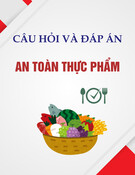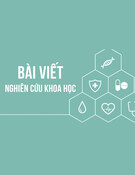
GS TS BS LÊ HOÀNG NINH
Biên soạn theo tài liệu của CDC, FDA Hoa
kỳ,center for food security and public health…

Nội dung
Organisms
History
Epidemiology
Transmission
Foodborne illness
Prevention and Control
Center for Food Security and Public Health Iowa State University 2004

Vi sinh vật
Estimated 250 foodborne pathogens
Foodborne illness
2 or more cases of a similar illness resulting
from ingestion of a common food
Bacteria most common cause
Also viruses, parasites, natural and
manufactured chemicals, and toxins from
organisms
Center for Food Security and Public Health Iowa State University 2004

Foodborne
disease
outbreaks,
cases and
deaths
1993-1997
Salmonella
had the
highest
number
Center for Food Security and Public
Health Iowa State University 2004


















![Bài giảng Chế biến khoáng sản vô cơ [Mới nhất]](https://cdn.tailieu.vn/images/document/thumbnail/2025/20251025/thanhvan173002/135x160/21521761538638.jpg)








